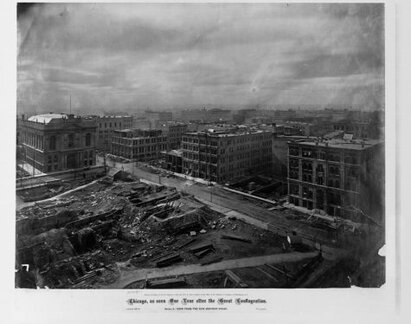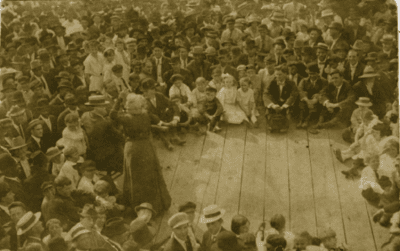Labor organizer Mother Jones returned to West Virginia last month, given a new voice through author Karen Spears Zacharias as part of the Appalachian Heritage Writer-in-Residence series, organized by AHWIR Project Director Dr. Sylvia Shurbutt.
Zacharias was hesitant to travel from Oregon to West Virginia to speak about Jones, citing the labor organizer as a personal hero.
“What can I tell you that you don’t already know?” she asked.
West Virginians may know Mother Jones and her work in the West Virginia labor struggle, fighting on behalf of miners, millers, textile and steel workers, and as one of the primary organizers of the Industrial Workers of the World.
Yet, not many people know Mary Harris, the person who would decades later become a fearless representative of the American working class. Her union organizing may be legendary, but her formative years were equally profound, Zacharias said.
“I think it’s that part of her life that formed her into the activist she became,” she said.
Mary Harris was born in the 1830s to Ellen and Richard Harris in Inchingeelagh, Ireland, a small rural village of about 6,000 people. However, growing industry and English colonial policy impoverished the country, forcing the Harris family to move from Inchingeelagh to nearby Cork, a city much larger than their idyllic village, Zacharias said.
“What was happening in Ireland at the time is not much different than what we’re dealing with in this country with the wealth gap,” she said. “Eighty percent of all land in Ireland was owned by the English. And 80 percent of the wealth.”
Under these circumstances, many downwardly mobile Irish unable to pay rents were forcibly dispossessed of their homes by militias acting on behalf of the English aristocracy.
“I can’t help but think that as Mary was growing up, watching these people being thrown out of their homes, she was certainly being impacted,” Zacharias said. “And then what happened in 1848? The Irish potato blight.”
The potato famine wiped out the primary source of food for a country of 8 million people whose homes were being taken by force through English colonial law.
“Thus begins several years of great despair among the people,” she said. “One million people died, and over 2 million emigrated.” Over the next seven years, Ireland’s population would fall by nearly 38 percent.
Zacharias said it was likely all of this —homelessness, population decline, poverty, famine — that forged in young Mary Harris not only the deep distrust of authority she would be known for, but also the nascent motivation to fight for working people, the downtrodden, the dispossessed.
As the famine worsened in the latter part of 1848, Mary’s father emigrated with his oldest son to Vermont and then settled in Toronto, Canada, leaving Ellen Harris and the other children behind in Cork. Eventually, Ellen Harris and the rest of the children made the transatlantic journey and found themselves a reunified family.
Mary performed well academically, and when she graduated high school, she enrolled in the Toronto Normal School. Though, she soon found after a year that she no longer wished to pursue her education. She would briefly act as a private tutor in Maine, and then as a school teacher in Monroe, Michigan. She found little joy in this as well.
“In Mary Harris’ own words,” Zacharias said, “‘I prefer sewing to bossing around little children.’”
After spending some time in Chicago as a seamstress, she relocated to Memphis, Tennessee, where she would meet her future husband, George Jones, an iron molder who helped form Local 66, the Memphis branch of the International Iron Workers Union.
The two had four children — one boy and three girls. But not for long. At 30 years old, Mary Harris found herself mired in tragedy. The third major yellow fever epidemic of Memphis swept away in less than one week the life Mary had assembled.
Zacharias noted Harris’ anguish: “She said, ‘One by one, my four little children sickened and died. I washed their little bodies, and got them ready for burial. My husband caught the fever and died. I sat alone through nights of grief. No one came to me. No one could. All day long, all night long. I heard the grating of the wheels of the death cart.’”
This event did not fully sway her from the greater good, however. Mary Harris applied for a license to help those who were quarantining during the remainder of the epidemic.

As yellow fever waned in Memphis, Mary moved back to Chicago to work once again as a seamstress, starting her own business making dresses for Chicago’s moneyed class. It seemed, though, Mary could not escape calamity.
Misfortune struck again. The Great Chicago Fire of 1871 burned over three miles of the city, and Mary Harris’ business was not spared.
She was forced into homelessness, along with more than 100,000 Chicagoans.
“I believe Mary Harris died in that fire,” Zacharias said.

It was here where Harris noticed that the Knights of Labor, one of the first national labor union formations, was the only group bringing food and clothing to Chicago’s newly impoverished population. It was here, too, where her love for revolutionary socialism and industrial unionism grew.
Over the next several decades, Mary Harris, now Mother Jones, would immerse herself in the labor struggle, toiling to ensure working conditions were improved and workers received payment for the full value of their labor.
She fought against child labor.
She fought for the 8-hour day.
She would organize with Eugene Debs, and she would write letters to presidents, like Teddy Roosevelt, who chose not to engage the organizer.
Mary Harris did not accept.
“The one thing she would not do, ever in her life, was be ignored,” Zacharias said.

Leave a Reply